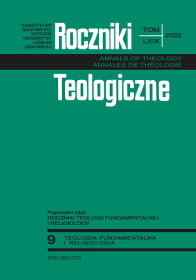KOŚCIÓŁ POMIĘDZY NEGACJĄ A AKCEPTACJĄ ŚWIATA
THE CHURCH BETWEEN NEGATION AND ACCEPTANCE OF THE WORLD
Author(s): Tadeusz DolaSubject(s): History of Church(es), Systematic Theology, Pastoral Theology, Sociology of Religion
Published by: Towarzystwo Naukowe KUL & Katolicki Uniwersytet Lubelski Jana Pawła II
Keywords: Church; world; negation; acceptance; the kingdom of God;
Summary/Abstract: The article addresses the problem of the Church’s relationship to the world. Christians have always been aware that they have been sent into the world to preach the Gospel, with the consequent aim of transforming the world so that the kingdom of God initiated by Christ could be realised in it. Thus, the mission of Christ’s disciples had to involve engaging with the surrounding reality in its social, political, cultural and economic dimensions. The aim of this article will be to show how Christians understood and implement their participation in shaping the human world. It is quite apparent that Christians have always faced (up until today) a dilemma that can be summarised in the phrase: the Church between negation and acceptance of the world. The unravelling of this dilemma was influenced mainly by two factors. The first was the awaiting of the end of time, which was to be brought about by the final coming of the kingdom of God. This motif in shaping the attitude of Christians towards the world played a decisive role in the first generations of Christ’s disciples, although it was also significant in later centuries. The second factor was the legal status of Christianity — above all in the Roman Empire, where Christianity took its roots most deeply and spread most widely. With these initial assumptions in mind, the article first examines the question of Christians’ hope for the imminent arrival of the kingdom of God, which had a significant impact on their activity in the temporal world. In the next stage of consideration, the period in which the radical change in the legal status of Christianity took place at the time of Constantine the Great and his successors is examined. These transformations fundamentally altered the Church’s relationship to the world while the legal and social position of the Church formed at that time affected for centuries the manner in which the Church was present in the world. The consequences of the transformations of the Constantinian era have persisted essentially into modern times. The examination of this issue has become the subject of the final section of this article.
Journal: Roczniki Teologiczne
- Issue Year: 69/2022
- Issue No: 9
- Page Range: 65-85
- Page Count: 21
- Language: Polish

